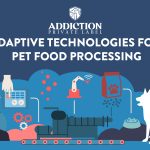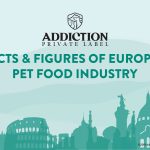By Andrew Prest, PhD Microbiology
Dogs share some carnivorous traits with cats as both lack salivary amylase, have a short gastro intestinal tract and are unable to synthesize vitamin D (National Research Council, 2006). In contrast, there are 3 genes, AMY2B, MGAM and SGLT1 that have evolved only in dogs during domestication and are involved in starch digestion and glucose uptake(1).
Another characteristic of the dogs digestive system is that they can synthesise several essential nutrients such as niacin, taurine and arginine. Several studies focused on the role of functional foods in dog nutrition(2):
FOS alone or in combination with MOS plus poultry by-product meal, brewers rice, poultry fat, beet pulp, dehydrated egg, sodium chloride, potassium chloride, choline chloride, vitamin premix and mineral premix
Health benefit: ↑ ileal immunoglobulin A, ↓ fecal total indole and phenol concentrations (3)
Oligofructose. Health benefit ↓ levels of Clostridium perfringens(4)
Poultry fat combined with 12% stabilized rice bran Defatted rice bran diet combined with poultry fat, beef tallow, or poultry fat:soybean oil (50:50)
Health benefit ↑ food intake and palatability ↓ plasma phospholipid total monounsaturated fatty acids(5)
Peas. Health benefit ↓ glycemic index value(6)
Corn, beet pulp, yeast, fish oil, minerals, dried yeast (Bio MOS), FOS, Yucca schidigera, Vitamin A (15,000 IU), Vitamin D3 (1080 IU), Vitamin E (180 mg), choline chloride (1000 mg), copper chelate of amino acids hydrate (20 mg), DLmethionine (500 mg), taurine (1500 mg), L-carnitine (500 mg), extract rich in natural tocopherols (44.3 mg), Rosmarinus officinalis (Rosemary) 0.84 mg, Grifola frondosa (mushroom) 270 mg, Curcuma longa (Turmeric) 263 mg, Carica papaya (Papaya) 151 mg, Punica granatum (pomegranate), Aloe vera (92 mg), Polygonum L. (buckwheat) 82 mg, Haematococcus pluvialis (astaxanthin rich micro algae) 74 mg, Solanum lycopersicum (tomato) 25 mg, and Vitis vinifera (grape vine) 19 mg.
Health benefit ↓ Body Condition Score, d-ROMs, hematocrit, and platelets ↑ BAP (biological antioxidant potential)(7)
Antioxidants, phytotherapic compounds, vitamins, and trace elements
Health benefit ↑ metabolic activity (free thyroxine and testosterone) and a consequent positive effect on fertility and thyroid activity ↑ semen motility and vitality(8)
Fish meal, propolis (0.0161%), Salvia officinalis (0.0087%), egg albumen (lysozyme 0.0078%), dehydrated orange extract (bioflavonoids 0.0077%), Thymus vulgaris (0.0127%), and Ribes nigrum (0.0040%)
Health benefit ↓ halitosis volatile sulphur compounds (methyl mercaptan, hydrogen sulphide and dimethyl sulphide)(9)
Rice carbohydrates, Grifola frondosa, Curcuma longa, Carica papaya, Punica granatum,, Aloe vera, Polygonum cuspidatum, Solanum lycopersicum, Vitis vinifera, Rosmarinus officinalis, and an Omega 3 and Omega 6 ratio of 1:0.8
Health benefits ↑ BDNF ( brain-derived neurotrophic factor) ↓ d-ROMs (derivatives of reactive oxygen metabolites)
The canine model in the last study above has been used to investigate the relationship among cognitive impairment in aging, brain-derived neurotrophic factor (BDNF) and diet, but also among behavioral disturbances, neuroendocrine parameters modification and diet. These studies showed that dogs receiving two different antioxidant- and botanical-enriched diets presented significantly higher BDNF lower d-ROMs and normalized neuroendocrine parameter levels as well as an overall improvement in behavioral disturbances and their related clinical signs.
Antioxidants
An antioxidant is a substance that inhibits oxidation. Oxidation is a chemical reaction that can produce free radicals that may damage cells and organisms leading to chronic health outcomes such as cancer.
Of the individual antioxidants, vitamin E (Tocopherol) has been studied the most. The NRC (National Research Council) suggested that 22 mg/kg of diet would be adequate. However, in diets high in PUFA, even as much as 100 mg/kg of vitamin E may be insufficient, and a vitamin E to PUFA ratio of 0.6:1 should be considered as the minimum.
A recent examination of vitamin inclusion in pet food showed a wide variation in the use of vitamin E, ranging from 14 to 400 mg/kg of diet (adjusted to 400 kcal/100 g). Levels as high as 500 mg/kg have been shown to be beneficial to antioxidant capacity.
READ ON: Pet Food and Sustainability
Looking for a new partner to help you perfect your pet food formulation?
Discover what Addiction Foods Private Label can do for you and your own brand.
About Dr Prest
Andrew Prest is the Founder and Managing Director of Sustainability Systems. He has extensive theoretical and practical understanding of food manufacturing processes and systems having held senior management positions with major global food and beverage manufacturers for over 20 years supported by a Masters in Food Technology and Quality Assurance and a PhD in Food Microbiology. Andrew has significant experience in auditing and integrated systems management within the Quality, Food Safety, Health & Safety and Environmental Management sphere.
__________
References:
(1) Axelsson, E., Ratnakumar, A., Arendt, M.L., Maqbool, K., Webster, M.T., Perloski, M., Liberg, O., Arnemo, J.M., Hedhammar, A., Lindblad-Toh, K., 2013. The genomic signature of dog domestication reveals adaptation to a starch-rich diet. Nature 495, 360–364.
(2) Alessandro Di Cerboa,1, Julio Cesar Morales-Medinab,1, Beniamino Palmieric, Federica Pezzutodi, Raffaella Coccoe, Gonzalo Floresf, Tommaso Iannitti. Functional foods in pet nutrition: Focus on dogs and cats Research in Veterinary Science 112 (2017) 161–166
(3) Swanson, K.S., Grieshop, C.M., Flickinger, E.A., Bauer, L.L., Healy, H.P., Dawson, K.A., Merchen, N.R., Fahey Jr., G.C., 2002. Supplemental fructooligosaccharides and mannanoligosaccharides influence immune function, ileal and total tract nutrient digestibilities, microbial populations and concentrations of protein catabolites in the large bowel of dogs. J. Nutr. 132, 980–989. \
(4) Flickinger, E.A., Schreijen, E.M., Patil, A.R., Hussein, H.S., Grieshop, C.M., Merchen, N.R., Fahey Jr., G.C., 2003. Nutrient digestibilities, microbial populations, and protein catabolites as affected by fructan supplementation of dog diets. J. Anim. Sci. 81, 2008–2018.
(5) Spears, J.K., Grieshop, C.M., Fahey Jr., G.C., 2004. Evaluation of stabilized rice bran as an ingredient in dry extruded dog diets. J. Anim. Sci. 82, 1122–1135.
(6) Adolphe, J.L., Drew, M.D., Huang, Q., Silver, T.I., Weber, L.P., 2012. Postprandial impairment of flow-mediated dilation and elevated methylglyoxal after simple but not complex carbohydrate consumption in dogs. Nutr. Res. 32, 278–284
(7) Pasquini, A., Roberti, S., Meucci, V., Luchetti, E., Canello, S., Guidetti, G., Biagi, G., 2013. Association between body condition and oxidative status in dogs. Food Nutr. Sci. 4, 191–196.
(8) Ponzio, P.C., Canello, S., Guidetti, G., Sferra, C., Macchi, E., 2013. Correlation between reproductive efficiency (semen quality and endocrine function) and dietary supplementation in dog breeding. Veterinaria 27, 15–22.
(9) Di Cerbo, A., Palmieri, B., 2015. Review: the market of probiotics. Pak. J. Pharm. Sci. 28, 2199–2206.









